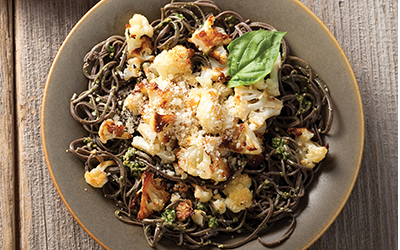America has become a protein nation. Walk into practically any grocery store and you’ll find yourself surrounded by an astonishing selection of protein packed products. Popular diets like Atkins, the Zone and South Beach have been kicking carbs off many people’s plates and replacing them with generous servings of protein. Meats, eggs and nuts – foods once seen as “heavy” – are now being embraced as the core of a lean and healthy diet. Athletes and gym-goers often rely on protein bars, drinks and other protein supplements to fuel and recover from workouts.
Certainly, getting adequate protein is essential to health and fitness. But are we too pro-protein?
The truth is that while protein plays a vital role in nutrition and exercise, downing more of it than you need puts unnecessary stress on your body and can cause a variety of health problems. Having a better understanding of what protein is, and how it works in the body, can help you make smarter food decisions.
Going to the Source
Make no mistake about it – protein is a vital nutrient. It’s present everywhere in the body, from your cells to your bodily fluids. “Protein is a major energy source and a building block for muscles, organs, hormones, hair and nails,” says Johanna Dwyer, PhD, professor of medicine and community health at Tufts School of Medicine in Boston. In fact, 60 to 70 percent of it is located in the skeletal muscles. Protein is also the major component of glands and helps maintain the skin, tendons and ligaments. The body relies on protein to regulate hormone secretion, maintain the body’s water balance, carry oxygen, regulate blood clotting, create enzymes and help manage a healthy immune system.
Proteins are made up of amino acids. Next to water, protein is the most plentiful substance in the body. There are approximately 20 amino acids that the human body requires for growth, but the body produces only 13. These 13 amino acids are called the nonessential amino acids. The others (essential amino acids) must be obtained from protein in food.
There are two kinds of protein sources: complete and incomplete. Complete proteins provide the essential amino acids; the incomplete provide only some of them.
- Complete proteins are primarily animal proteins, such as beef, lamb, pork, poultry, fish, shellfish, eggs and dairy products.
- Plant proteins (incomplete proteins), such as grains, fruits and vegetables, lack at least one of the essential amino acids. Yet they can be combined in various ways to form complete proteins.
For example, corn alone is an incomplete protein, but add some beans and you get a complete protein containing all the essential amino acids. As a result, most people actually get far more protein than they think; consequently, they may consume more meat than they really need to.
How Much Is Enough?
The way Americans consume protein gives the impression that you need vast quantities just to survive. But that’s not really the case. Your need for protein is directly related to your size, activity level, overall balance of food intake and the demands or stresses you are placing on your body. And unless you are training heavily, it probably isn’t as great as you think.
The U.S. Department of Agriculture (USDA) recommends that the average person get 0.8 grams of protein per kilogram of body weight per day. One kilogram equals 2.2 pounds, hence: 0.364 grams per pound. Thus, a 175-pound man can fill his daily protein quota of 63.7 grams by eating just 11/2 cups of chicken, and a woman weighing 125 pounds needs only about one-half of a salmon fillet – or 45.5 grams of protein. (See “Where’s the Protein?” below, for other food sources.)
This guideline, however, is aimed at the average (sedentary) individual. Active people generally require more protein, according to Susan Kleiner, PhD, RD, author of Power Eating. “As your energy requirements increase, so do your protein needs,” she explains. “For instance, if your goal is to build more muscle, your protein needs will be different than they would be with an endurance endeavor like long-distance running.”
“If your goal is to build more muscle, your protein needs will be different than they would be with an endurance endeavor like long-distance running.”
We know that active people need more protein, but how much more? That’s long been one of the most debated questions in nutrition. Most experts agree that it depends on several factors, including your weight, fitness level and goals, and your type of workout or activity. With so many factors at play, it’s no surprise that exact measurements are difficult to pin down.
Research by Peter W. R. Lemon, PhD, of the Exercise Nutrition Research Laboratory at the University of Western Ontario, has found that daily protein needs increase about 50 percent to 75 percent for aerobic (endurance) exercise and as much as 100 percent for strength training.
Most recommendations for active people significantly exceed the USDA’s recommended 0.8 grams per kilogram of body weight (g/kg). For example:
If you are an average man in reasonably good shape who works out for 30 minutes three times per week, and has no performance goals, your daily needs are about 1.2 to 1.5 g/kg, according to Kleiner.
Someone who does mostly endurance activities needs approximately 1.6 to 1.8 g/kg, she says, while a person whose goal is to build muscle should increase his or her daily intake to 1.7 to 2.2 g/kg.
The Pros of Protein
Workout enthusiasts need protein because it helps repair and build body tissues after exercise, especially muscle tissue. Yet protein is not critical for fueling the muscles during workouts. For that you need carbohydrates, says Christine Rosenbloom, PhD, RD, of the department of nutrition at Georgia State University. “If your carbohydrates are in short supply, protein can then be used as fuel, but it’s inefficient,” she says, “and you are diverting the protein from its more important role, which is helping to stimulate muscle growth.”
So to make the most of your workouts, you need carbs along with protein. But it’s not just the combination of protein and carbs that’s critical, it’s also the time when they are consumed. An hour to an hour and a half before a workout, the average fit man or woman should consume 200 to 250 calories with a 2 to 1 ratio of carbs to protein, according to Kleiner. “Any kind of small meal or snack will do it,” she says. “Try whole grain bread with a slice of turkey, a peanut butter and banana sandwich, or mix some pineapple and its juices into yogurt. What you don’t want to do is just take one without the other. Pre-workout, you also want to avoid foods that are too high in fiber or sugary.”
After your workout, the necessary calorie intake rises to approximately 300 calories for a woman and 500 to 600 for a man, with the carbs-to-protein ratio increasing to 4 to 1 to help replenish the nutrients just burned. (There is not enough substantial research to support the idea that taking protein during workouts provides significant benefits, Kleiner says.)
Eat the same types of foods after your workout as you do before your workout, she advises, or add a healthy nutrition bar, easy-to-digest shake or some other liquid supplement with the right protein-to-carb ratio.
Whatever you choose, just be sure you don’t wait too long after your workout. Research has shown that 15 to 30 minutes after a workout is the most effective time to restore amino acids and carbs in the muscles. Kleiner notes that while this window can last up to two hours, the rate of glycogen replenishment decreases the longer you wait.
Kleiner also points out that all these recommendations are directed toward maximizing recovery and fitness gains, and not toward weight loss. If you are watching your weight, you’ll want to consider your caloric intake, too.
Setting Limits
Many people don’t realize that eating excess protein can be problematic or that consuming extra protein doesn’t necessarily translate into creating more muscle. “The maximum muscle mass the human body can add in one week is 1 pound,” says Covert Bailey in Smart Exercise: Burning Fat, Getting Fit. “That is the upper limit of the muscle fibers’ capacity to make protein into muscle; any protein beyond that is simply converted to fat.”
Then there are other health concerns related to high-protein intake, such as increased risks of dehydration, exacerbated kidney problems and possibly even heart disease. A recent study by the University of Connecticut’s Department of Nutritional Sciences found that a high-protein diet (four times the USDA’s guideline of 0.8 g/kg) caused the kidneys of several student-athlete runners to produce more concentrated urine over a four-week period than those who consumed a low-protein diet that complied with the USDA guidelines. The reason is that when the body breaks down protein, nitrogen is removed and is then disposed of through urine. Thus, the more protein you eat, the more your kidneys have to work to get rid of the nitrogen.
Many people don’t realize that eating excess protein can be problematic or that consuming extra protein doesn’t necessarily translate into creating more muscle.
This strain on the kidneys is even more serious for those with kidney ailments. The Annals of Internal Medicine (March 18, 2003) reported that high protein intake accelerated the decline in kidney function among women with mildly reduced kidney function. (Researchers also observed that a high-protein diet did not adversely affect normal functioning kidneys.)
A high-protein diet’s influence on heart disease, though, is not as definite. High-protein diets tend to promote eating more meat, eggs and dairy products, which are generally high in fat, saturated fat and cholesterol, says Patricia Kendall, PhD, RD, food science and human nutrition specialist at Colorado State University. Experts have long believed that consuming high amounts of these ingredients greatly increases a person’s risk of heart disease.
But Kendall points out that popular high-protein diets actually lower serum lipid levels (cholesterol levels) – at least in the beginning. “But lower lipid levels are also associated with a decrease in weight,” she says, referring to high-protein diets’ popularity for quick weight loss. “So in the short run a person’s lipid levels often go down, but that doesn’t mean that high-protein intake won’t cause the levels to increase down the road.” Kendall adds that several studies are currently underway that will examine the effects of high-protein diets over a two-year or longer time period.
A Happy Medium
Staying within the guidelines of protein intake for active people is not that difficult. Many experts believe that most individuals can easily meet or exceed their needs by following a regular diet. In fact, the American College of Sports Medicine (ACSM) recently issued a position paper claiming that “although carbohydrates, proteins and fats all contribute to the energy burned during athletic performance, data is not available to suggest that an athlete needs a diet substantially different from that recommended for the general population.”
That’s probably because most Americans typically exceed the USDA’s 0.8 g/kg of daily protein without realizing it. Look at it this way: A typical turkey and cheese sandwich has about 40 grams of protein. Add a glass of milk and a nonfat yogurt and the protein quota has already been met – and that doesn’t include dinner or any of the proteins from plant-food combining. Dine on a 12-ounce steak (nearly 85 grams of protein) and the daily total tops 140 grams – more than double the amount the USDA has set for the average couch potato, but right in line with what many experts recommend for exercisers.
As with any dietary concern, when it comes to protein, moderation is the key. Going too heavy on the protein won’t help you lift more weight or run faster, it will just put extra pressure on your body’s digestive, detoxifying and immune systems. Until more is known about the long-term health risks of ingesting excess protein, it’s best to keep your protein intake within range of the recommended guidelines for your weight and activity level. In this case, a little really can go a long way.
Where’s the Protein?
- Cooked chicken, 1 cup: 42.59 grams
- Salmon, 1/2 fillet: 42.33 grams
- Low-fat cottage cheese, 1 cup: 28 grams
- Beef, 3 ounces*: 23.64 grams
- Cooked soybeans, 1 cup: 22.23 grams
- Cooked lentils, 1 cup: 17.86 grams
- Plain, nonfat yogurt, 8 ounces: 13.01 grams
- Nonfat milk, 1 cup: 8.26 grams
- Peanuts, 1 ounce: 7.95 grams
- Plain bagel, 1: 7.46 grams
- Cheddar cheese, 1 ounce: 7.06 grams
- Hard-boiled egg, 1 large: 6.29 grams
- Brown rice, 1 cup: 5.03 grams
- Raisins, 1 cup: 4.45 grams
- Corn, 1 ear: 2.56 grams
- Orange juice, 1 cup: 1.74 grams
- Raw carrots, 1 cup: 1.02 grams
- Cooked broccoli, 1 spear: 0.88 grams
*One ounce of meat = 1 slice of deli meat. Three ounces of meat is approximately the size of a deck of cards or the palm of a woman’s hand.
Source: USDA National Nutrient Database for Standard Reference




This Post Has 0 Comments